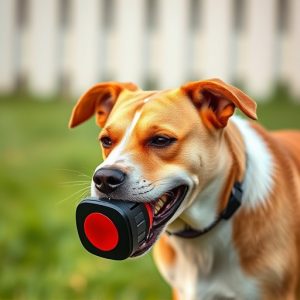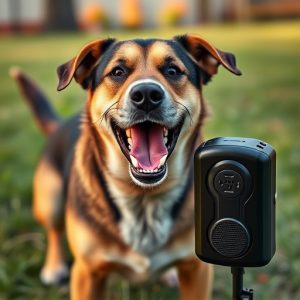Mastering Sonic Dog Repellents: Adjusting Training for Effective Control
Dog repellents with distance control use ultrasonic sound or spray to manage canine behavior in vari…….
Dog repellents with distance control use ultrasonic sound or spray to manage canine behavior in various settings. To maximize effectiveness, adjust training levels based on dog reactions and sensitivity. Start at low intensity, gradually increase as the dog's avoidance of targeted areas improves. Implement strategic positioning, regular device maintenance, and combination with other deterrents for optimal results while prioritizing dog well-being.
Tired of unwanted dog visitors in your yard? Discover the power of sonic dog repellents—a humane and effective solution. This comprehensive guide explores how these devices use sound waves to deter dogs from entering specific areas, offering distance control for tailored protection. We’ll delve into adjusting training levels, ensuring optimal performance, and share best practices for successful implementation. Learn how to create a peaceful outdoor space while maintaining a harmonious relationship with local canines.
- Understanding Dog Repellents with Distance Control
- Adjusting Sonic Repellent Training Levels: A Step-by-Step Guide
- Best Practices for Implementing Sonic Dog Repellents
Understanding Dog Repellents with Distance Control
Dog repellents with distance control offer a innovative solution for managing canine behavior in various settings, from urban parks to agricultural fields. These devices utilize a range of technologies, most commonly ultrasonic sound or spray, to deter dogs from entering specific areas without directly harming them. Understanding how these repellents work and adjusting their training levels is crucial for maximizing effectiveness.
Adjusting the sonic repellent training levels involves fine-tuning the device’s sensitivity and frequency output. By modifying these settings, users can target particular dog behaviors, such as barking or approaching too closely. For instance, raising the training level can increase the range and intensity of the ultrasonic sound, making it more effective for larger areas or stubborn dogs. Conversely, lowering the level can make the repellent gentler, suitable for sensitive environments or younger animals that might be startled by stronger stimuli.
Adjusting Sonic Repellent Training Levels: A Step-by-Step Guide
Adjusting the training levels on a sonic dog repellent is a crucial step to ensure its effectiveness and safety. Start by consulting your device’s manual for specific guidelines. Generally, most sonic repelents offer several intensity settings, usually labeled as low, medium, or high. Begin with the lowest setting during initial training sessions to gauge your dog’s reaction without overwhelming them. Gradually increase the level as their sensitivity decreases, moving up a notch after they demonstrate consistent avoidance of the targeted area. Regularly monitor your dog’s behavior and make adjustments accordingly; they should not display signs of distress or anxiety when exposed to the sonic signal.
For step-by-step guidance, first, power on the device and select the desired training mode. Then, choose an appropriate frequency setting suitable for your dog’s size and sensitivity (higher frequencies may be better for smaller dogs). Next, set the intensity level and begin training in a controlled environment. Keep an eye on your dog’s response; if they seem undisturbed, slowly increase the intensity. Conversely, if they exhibit fear or discomfort, reduce the level until they are more relaxed. It might take several sessions to find the optimal balance, but persistence will help you achieve the best results while ensuring your dog’s well-being.
Best Practices for Implementing Sonic Dog Repellents
Implementing sonic dog repellents effectively requires a thoughtful approach and understanding of canine behavior. Begin by identifying problem areas where dogs tend to gather or intrude. These could be gardens, patios, or specific rooms in your home. Adjusting the sonic repellent’s training levels is key; start at a low setting to familiarize dogs with the sound, gradually increasing it as needed. Consistency is crucial; play and pause the device regularly to mimic natural patterns, teaching dogs to associate the sound with an unpleasant experience without causing lasting harm or stress.
Additionally, positioning is vital. Place the repellents at strategic points where dogs are likely to approach, ensuring they emit the sound when triggered by movement. Regular maintenance includes checking battery life and cleaning sensors to ensure optimal performance. Remember, these devices are most effective as part of a multi-layered approach, combined with visual deterrents, scent barriers, or training methods to create an environment that discourages dog intrusion naturally and humanely.
Dog repellents with distance control offer a humane and effective solution for managing dog interactions in specific areas. By understanding how these devices work and implementing best practices, you can ensure they are used responsibly. Remember, adjusting the training levels of sonic repelents is crucial to their effectiveness, allowing you to tailor the intensity of the deterrent to the environment and desired results. With proper use, these tools can foster a peaceful coexistence between humans and canines in shared spaces.


